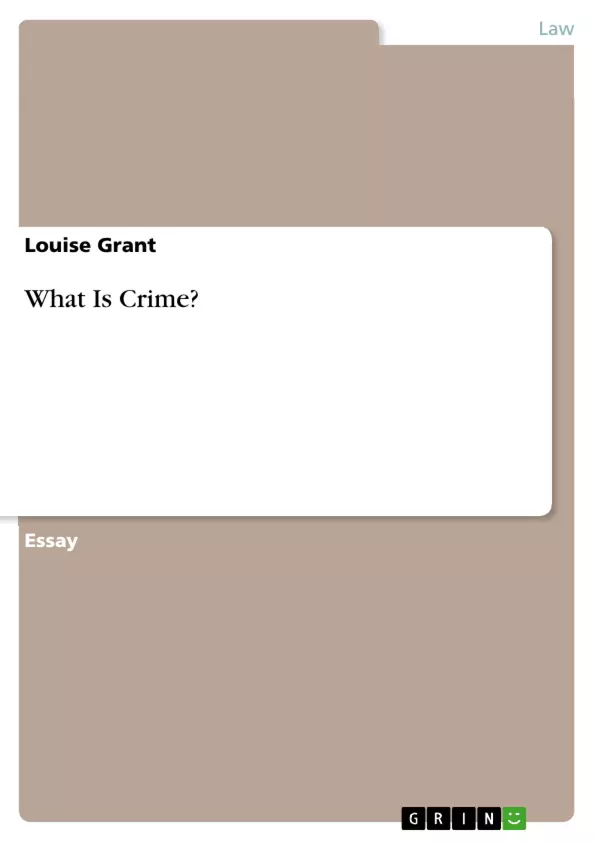There are many perceptions of what defines crime. The definitions appear to change throughout history and are still changing today (Henry, S. and Lanier, M. M., 2001 ,p.139). For example, in the past marital rape was not considered a crime as it was thought that women were believed to be “sexual property” of the male and, therefore it couldn’t be classed as rape (Brownmiller, 1975, cited by Bergen, R.K., 1996, p.3) [...]
Inhaltsverzeichnis (Table of Contents)
- What Is Crime?
Zielsetzung und Themenschwerpunkte (Objectives and Key Themes)
The main objective of this essay is to explore the complex and multifaceted concept of "What is Crime?". It aims to demonstrate the lack of a universally accepted definition and highlight the factors that influence its interpretation across different cultures and historical periods.
- The evolving nature of crime definitions across time.
- Cultural variations in perceptions of crime.
- The influence of social norms and power structures on crime definitions.
- The role of the media in shaping public perception and influencing legislation.
- The limitations of solely psychological explanations for crime.
Zusammenfassung der Kapitel (Chapter Summaries)
What Is Crime?: This chapter delves into the complexities of defining crime, highlighting its fluid nature across different historical periods and cultures. The author demonstrates this fluidity by citing examples such as the changing legal status of marital rape in the United States and varying perceptions surrounding marijuana use. Different definitions of crime are presented, emphasizing the role of legal punishment and the potential discrepancies between national laws. The chapter introduces three main theoretical approaches to understanding crime: the consensus view, the conflict view, and the influence of media representations. The consensus view posits that crime is defined by societal disapproval of actions, while the conflict view attributes crime to class struggles and inequalities. The impact of media portrayal in shaping the public’s understanding and thus influencing legal frameworks is also explored, showing the difficulties of arriving at a singular definition of crime.
Schlüsselwörter (Keywords)
Crime definition, cultural variations, historical context, social norms, power structures, media influence, legal frameworks, consensus view, conflict view, marijuana legalization, marital rape.
Frequently Asked Questions: A Comprehensive Language Preview
What is the main topic of this language preview?
This preview covers a text exploring the multifaceted concept of "What is Crime?". It delves into the complexities of defining crime, highlighting its fluidity across different historical periods and cultures.
What are the key themes explored in the text?
Key themes include the evolving nature of crime definitions across time, cultural variations in perceptions of crime, the influence of social norms and power structures, the role of the media in shaping public perception, and the limitations of solely psychological explanations for crime.
What is the objective of the text?
The main objective is to demonstrate the lack of a universally accepted definition of crime and highlight the factors influencing its interpretation across different cultures and historical periods.
What theoretical approaches to understanding crime are discussed?
The text introduces three main theoretical approaches: the consensus view (crime defined by societal disapproval), the conflict view (crime attributed to class struggles and inequalities), and the influence of media representations in shaping public understanding and legal frameworks.
What examples are used to illustrate the fluidity of crime definitions?
Examples include the changing legal status of marital rape in the United States and varying perceptions surrounding marijuana use.
What is the role of the media discussed in the text?
The text explores the significant role of media portrayal in shaping the public’s understanding of crime and subsequently influencing legal frameworks.
What are some of the key terms or keywords associated with this text?
Key terms include: Crime definition, cultural variations, historical context, social norms, power structures, media influence, legal frameworks, consensus view, conflict view, marijuana legalization, and marital rape.
What does the chapter summary of "What Is Crime?" cover?
The chapter summary details the complexities of defining crime, highlighting its fluid nature across different historical periods and cultures. It discusses different definitions, the role of legal punishment, potential discrepancies between national laws, and the three main theoretical approaches to understanding crime (consensus, conflict, and media influence).
Where can I find a complete table of contents?
While a full table of contents is not provided in this preview, it mentions at least one chapter: "What Is Crime?".
- Arbeit zitieren
- Louise Grant (Autor:in), 2009, What Is Crime?, München, GRIN Verlag, https://www.grin.com/document/169105



